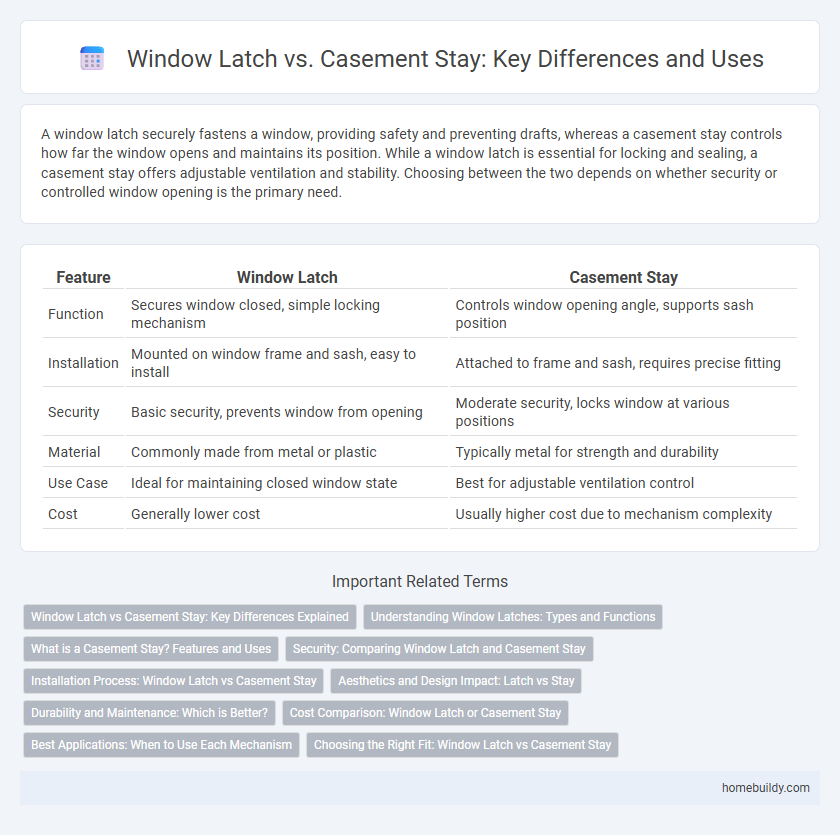A window latch securely fastens a window, providing safety and preventing drafts, whereas a casement stay controls how far the window opens and maintains its position. While a window latch is essential for locking and sealing, a casement stay offers adjustable ventilation and stability. Choosing between the two depends on whether security or controlled window opening is the primary need.
Table of Comparison
| Feature | Window Latch | Casement Stay |
|---|---|---|
| Function | Secures window closed, simple locking mechanism | Controls window opening angle, supports sash position |
| Installation | Mounted on window frame and sash, easy to install | Attached to frame and sash, requires precise fitting |
| Security | Basic security, prevents window from opening | Moderate security, locks window at various positions |
| Material | Commonly made from metal or plastic | Typically metal for strength and durability |
| Use Case | Ideal for maintaining closed window state | Best for adjustable ventilation control |
| Cost | Generally lower cost | Usually higher cost due to mechanism complexity |
Window Latch vs Casement Stay: Key Differences Explained
Window latches secure the window sash firmly within the frame, providing a tight seal and enhanced security, while casement stays primarily control the opening angle and position of casement windows. Unlike window latches, casement stays typically feature adjustable arms or bars that hold the window in a partially open state, allowing for ventilation without compromising safety. Selecting between a window latch and casement stay depends on the desired balance of security, window movement control, and ventilation needs.
Understanding Window Latches: Types and Functions
Window latches, designed to secure window sashes in place, differ significantly from casement stays, which primarily control the opening angle of casement windows. Key types of window latches include cam locks, espagnolette locks, and sliding bolts, each offering specific locking mechanisms tailored for security and ease of use. Understanding these variations helps in selecting the appropriate hardware to enhance window safety and operation efficiency.
What is a Casement Stay? Features and Uses
A casement stay is a metal bar used to hold casement windows open at various angles, providing adjustable ventilation and security. It typically features multiple notches or slots for positioning, ensuring precise control over the window opening size. Unlike a window latch, which primarily secures the window closed, the casement stay focuses on supporting and stabilizing the window in an open position.
Security: Comparing Window Latch and Casement Stay
Window latches provide a more secure locking mechanism by firmly fastening the window frame, reducing the risk of forced entry, while casement stays primarily hold the window open and offer limited locking capabilities. The robust design of window latches often includes key-operated or multi-point locking systems, enhancing security significantly compared to the simple hook or lever mechanism found in casement stays. Choosing a window latch over a casement stay ensures better protection against unauthorized access and improves overall window security performance.
Installation Process: Window Latch vs Casement Stay
The installation process for a window latch typically involves securing the latch mechanism directly onto the window frame and sash using screws, requiring precise alignment for smooth operation. In contrast, installing a casement stay requires attaching the stay arm to the window frame and the hinge side of the sash, often involving multiple pivot points to enable adjustable window positioning. Both installations demand accurate measurement and proper fastening but differ in complexity, with casement stays generally requiring more detailed adjustments for optimal functionality.
Aesthetics and Design Impact: Latch vs Stay
Window latches provide a sleek and minimalistic design, seamlessly integrating with modern window frames for a clean aesthetic appeal. Casement stays often present a more traditional and visible hardware element, which can add decorative detail but may interrupt the smooth lines of contemporary window designs. Choosing a latch over a casement stay enhances the overall visual flow, emphasizing subtlety and modernity in window hardware.
Durability and Maintenance: Which is Better?
Window latches offer enhanced durability due to their robust metal construction and simpler mechanical design, requiring minimal maintenance compared to casement stays, which involve multiple moving parts prone to wear and corrosion. The straightforward operation of window latches reduces the likelihood of malfunction and the need for frequent adjustments or replacements. Choosing window latches ensures long-term reliability and easier upkeep, especially in environments exposed to harsh weather conditions.
Cost Comparison: Window Latch or Casement Stay
Window latches typically cost between $5 and $20, offering an affordable solution for standard window security and ease of installation. Casement stays, designed to hold casement windows open securely, generally range from $15 to $40, reflecting their specialized functionality and durability. Choosing between a window latch and casement stay largely depends on budget constraints and specific window requirements, with latches being more cost-effective for simple security and stays providing enhanced control and safety for operable windows.
Best Applications: When to Use Each Mechanism
Window latches provide secure locking for sliding or double-hung windows, making them ideal for enhancing safety and ease of operation in these window types. Casement stays are best suited for casement windows, offering adjustable positioning and controlled ventilation by holding the window at various open angles. Choosing between a window latch and a casement stay depends on the window design and desired functionality: latches for secure closure and stays for flexible opening and airflow control.
Choosing the Right Fit: Window Latch vs Casement Stay
Selecting the right hardware for your window involves comparing window latches and casement stays based on security, functionality, and ease of use. Window latches provide a secure, simple locking mechanism ideal for standard sash windows, while casement stays offer adjustable support and locking positions for outward-opening casement windows. Evaluating the window type and desired control over ventilation helps determine whether a window latch or casement stay best suits your needs.
window latch vs casement stay Infographic

 homebuildy.com
homebuildy.com